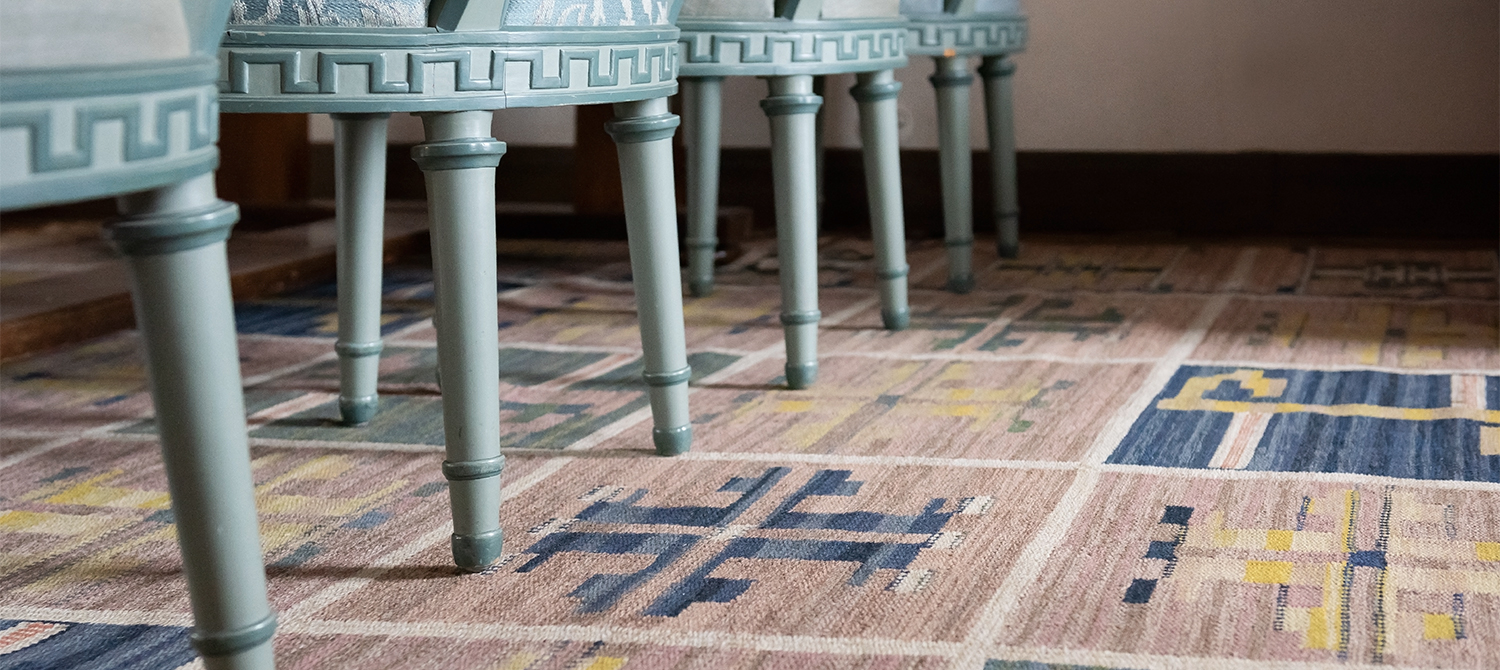Artwork in royal rooms
Over the years, the Royal Family have shown their support for Swedish craftsmanship. The work of Märta Måås-Fjetterström is one example. She received the Litteris et Artibus medal as early as 1924. At that time, this was the highest award a woman could receive.
Märta Måås-Fjetterström was a textile artist, designer and female entrepreneur who wanted to make "modern rugs for modern homes".
Textile art for generations
Märta Måås-Fjetterström's rugs have been used in royal settings for generations.
"The King himself grew up with Måås-Fjetterström's rugs in his home, and has been surrounded by them since his childhood." explains Kerstin Hagsgård, Curator of the Royal Collections.
"Her rugs have adorned the private rooms of the royal palaces. The King himself grew up with Måås-Fjetterström's rugs in his home, and has been surrounded by them since his childhood. However, most people are unaware of this because the private rooms have always been kept separate from the public royal spaces. There are – and always have been – smaller, more intimate rooms beyond the grandeur of the public rooms. These rugs have been used in slightly less formal rooms."
Commissions for royal rooms
The King's parents, Prince Gustaf Adolf and Princess Sibylla, furnished Haga with pieces including the Fågelträdet rugs, which were designed specifically for the couple in 1933, and with the boldly patterned Joakim rug. A short distance from Haga Palace is Ulriksdal, where a living room was furnished as a wedding gift for Crown Prince Gustaf (VI) Adolf and Crown Princess Louise in 1923-25. This includes the Ulriksdal rug, which was designed for the room. The Ulriksdal rug was the first of many to be commissioned for the home of King Gustaf VI Adolf. However, this was not the first time Märta Måås-Fjetterström's textiles had received recognition from royalty.
Awarded a medal by King Gustav V
When Crown Prince Gustaf (VI) Adolf and his first wife Margareta took over the summer palace of Sofiero at Helsingborg, the artistic Crown Prince was eager to update the drab, dated interiors. He incorporated several of Märta Måås-Fjetterström's textiles into the new, cosier décor.
"It soon became clear that she was something out of the ordinary."
"King Gustaf V also appreciated her work. Måås-Fjetterström received the Litteris et Artibus medal as early as 1924. At that time, this was the highest award a woman could receive. It soon became clear that she was something out of the ordinary," continues Kerstin.
"A clear signal for cultural Sweden"
However, Måås-Fjetterström's biggest royal fan was King Gustaf VI Adolf, who began buying her rugs on a large scale during the 1930s. It was well known that the King visited Måås-Fjetterström's studio every summer, which proved decisive for this female entrepreneur.
"The King's support was a clear signal for cultural Sweden."
King Gustaf VI Adolf took a keen interest in Swedish craftsmanship in general. He had sophisticated tastes, and was quick to buy pieces from bold young ceramicists such as Berndt Friberg and Carl-Harry Stålhane.
"The King's patronage was extremely important for Swedish artisans."
"The King's patronage was extremely important for Swedish artisans. It is, perhaps, less well known that he also purchased many works from young artists. For example, in 1972 – the year before he died – he bought a pencil sketch by a young Lena Cronqvist."
Timeless design and royal gifts
Märta Måås-Fjetterström's artistry was based on traditional Swedish craftsmanship and the patterns of Skåne. Looking at hyper modern rugs such as Blå Plump, which still looks very much at home in contemporary settings, it is hard to believe that she was once a classmate of the classic illustrator Elsa Beskow at the School of Industrial Art (now the University College of Arts, Crafts and Design). Märta Måås-Fjetterström was born in 1873, but her designs belong to a more recent period.
The Royal Court also purchased rugs by Måås-Fjetterström to give as gifts. When the Swedish Princess Märtha married the Norwegian Crown Prince in 1929, she received a Hästhagen rug as a wedding present. And when Queen Elizabeth II of Great Britain came to Sweden in 1956 on a state visit, The King presented her with a Vita Spetsporten rug.
When Märta Måås-Fjetterström died in 1941, the Royal Family continued to support the company. Even when her textiles fell out of popularity during the 1970s and the 1980s, they remained part of the Royal Collections.
"We don't just throw away older pieces at the royal palaces. Here, we use and care for the objects that we have."
Top image: The Ulriksdal rug was commissioned for the living room at Ulriksdal Palace in 1923. Photo: Sanna Argus Tirén/Royalpalaces.se

The Royal Family were quick to appreciate Måås-Fjetterström's work. As well as making their own acquisitions and visiting her workshop, her textiles were also purchased as royal gifts, including for Queen Elizabeth II of Great Britain. Archive image from Märta Måås-Fjetterström AB.

The large living room at Ulriksdal was a gift from the people of Stockholm to Crown Prince Gustaf (VI) Adolf and Princess Louise in 1923, and a one-off rug by Märta Måås-Fjetterström was commissioned for the room. Photo: Sanna Argus Tirén/Royalpalaces.se

The King's grandfather and great-grandfather were extremely fond of her work, and they both commissioned a significant number of rugs from her workshop. Photo: Hans Karlsson

King Gustav VI Adolf visited Märta Måås-Fjetterström's workshop in Båstad yearly. Here in 1970. Photo: Hans Karlsson

King Gustav V took a keen interest in craftsmanship, and carried out embroidery himself. The King recognised Måås-Fjetterström's work with a medal. Photo: The archive of the Bernadotte Library.

The Mr G rug by Märta Måås-Fjetterström. Mr G was the pseudonym King Gustaf V used when he competed at tennis. Photo from the virtual tour, click in the image to start the digital tour.

Exhibition curator Kerstin Hagsgård tells the story of the Royal Family and Märta Måås-Fjetterström. Photo: Emma Fredriksson/Royalpalaces.se











